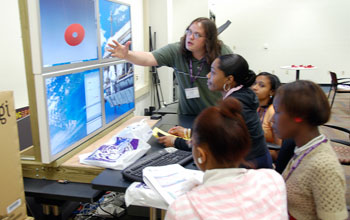Multimedia Gallery
The Amira visualization package helps high school students understand fluid flow in the eye.
Another NSF-funded cyber-enabled classroom tool is Amira Visualization. Wesley Evan, a Louisiana State University Ph.D. student in physics, shows local high school students how to use the Amira visualization package to understand fluid flow in the eye. On April 20, 2007, graduate students from the National Science Foundation's Computational Fluid Dynamics IGERT (Integrative Graduate Education and Research Traineeship) program at Louisiana State University (LSU) organized a workshop for 32 high school students and their teachers from Glen Oaks and Lee High Schools in Baton Rouge, La. Students spent the day at LSU's Center for Computation and Technology taking part in hands-on tutorials instruction to run black hole simulations on the Louisiana Optical Network Initiative (LONI) supercomputers, and doing scientific visualization using the Amira software.
Credit: Center for Computation and Technology, Louisiana State University
Images credited to the National Science Foundation, a federal agency, are in the public domain. The images were created by employees of the United States Government as part of their official duties or prepared by contractors as "works for hire" for NSF. You may freely use NSF-credited images and, at your discretion, credit NSF with a "Courtesy: National Science Foundation" notation.
Additional information about general usage can be found in Conditions.
Also Available:
Download the high-resolution JPG version of the image. (474 KB)
Use your mouse to right-click (Mac users may need to Ctrl-click) the link above and choose the option that will save the file or target to your computer.
Related story: NSF Funds Projects to Expand the Potential of the Administration's Digital Promise Initiative



